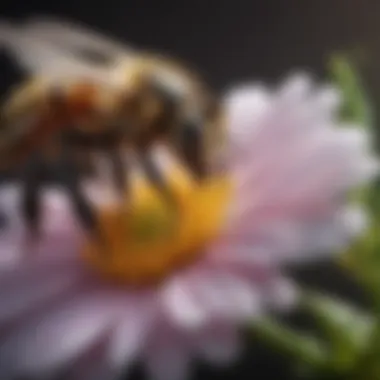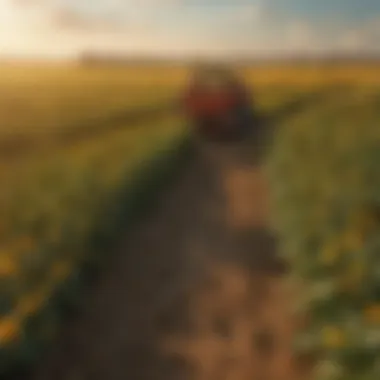The Critical Role of Bees in Human Survival


Intro
Bees are often overlooked in discussions about essential species for human survival. However, their importance cannot be understated. They play a crucial role in pollinating plants, which in turn is vital for food production and biodiversity. This introduction sets the stage for understanding the many dimensions of how bees contribute to ecosystems that support human life.
Throughout this article, we will explore several key aspects of the relationship between bees and humans. Topics will include the ecological functions of bees, the historical significance of their role in agriculture, and the current challenges they face in our changing world. Collectively, these facets will illustrate why bees are indispensable allies in maintaining not only our food supply but also the overall health of our planet.
Recognizing the decline in bee populations presents an urgent call for conservation. By examining the interconnected nature of bees, plants, and humans, we underscore the critical need to protect these pollinators. Let’s begin our journey by clarifying some key concepts and terminology.
Prologue to the Importance of Bees
The significance of bees cannot be understated. In this article, we will explore their critical role in sustaining not just our environment but also our food systems. Bees are not only fascinating creatures but also pivotal players in the health of ecosystems. Their contributions range from pollination to supporting biodiversity, making them essential for human survival.
One cannot ignore the ecological benefits provided by bees. They impact the growth and reproduction of countless plant species. Without bees, many of these plants would struggle to thrive, which would lead to a domino effect within the food chain. This fact underscores the necessity of bees in maintaining a balanced ecosystem.
Apart from ecological contributions, bees play a vital role in agriculture. They are responsible for a significant portion of the pollination needed by food crops. In turn, this directly impacts food production and availability. The relationship between bees and agriculture is complex, yet it is clear that the decline of bee populations poses a serious risk to food security. Therefore, understanding their role becomes crucial for farmers and agricultural enthusiasts alike.
In addition, historical context sheds light on how bee populations have fluctuated over time. These trends reveal not only the threats faced by bees but also the resilience found within nature. Within this framework, we will delve into the interaction between bees and their ecosystems, setting a foundation for further discussions.
Overview of Bees in Ecosystems
Bees serve as key pollinators in various ecosystems. They interact with numerous flowering plants, transferring pollen from one flower to another. This process not only aids in plant reproduction but also ensures genetic diversity within plant communities. Diverse plant life contributes to the stability and resilience of ecosystems.
There are about 20,000 known species of bees, each playing a unique role. Honeybees, bumblebees and solitary bees each contribute differently to pollination. While honeybees are known for their communal living, bumblebees are efficient pollinators of specific crops like tomatoes and peppers. Solitary bees, like mason bees, are also crucial for some plants. Understanding these differences is important for conserving bee populations.
The loss of bees could lead to a significant decline in certain plant species. This would not only reduce biodiversity but also disrupt the habitats of countless other organisms, creating ripple effects throughout food webs. Thus, the role of bees in ecosystems goes beyond mere pollination; they are the linchpins that hold ecological balance together.
Historical Context of Bee Populations
Historically, bee populations have seen various shifts due to human activity and environmental changes. In ancient agriculture, beekeeping was practiced for honey and wax. However, modern agricultural practices have placed immense pressure on these populations. Intensive farming, pesticide use, and habitat destruction have contributed to the decline of bees in many regions.
Records show a marked decline in bee species over the past few decades. This drop can be associated with multiple factors including neonicotinoid pesticides, which are particularly harmful to bee health. The implications are concerning as these insects are inextricably linked to our food systems. Awareness of these issues has begun to surface, prompting discussions about the need for sustainable practices.
Understanding the historical perspective allows us to appreciate the fragility of bee populations. It also invites us to consider proactive measures. By recognizing patterns from the past, we can work toward solutions that ensure the survival of these crucial pollinators for future generations.
Pollination and Food Production
The relationship between pollination and food production is pivotal in understanding how bees contribute to human survival. Pollination is the essential process by which pollen is transferred between the male and female parts of flowers, resulting in fertilization and the production of fruits and seeds. Bees, as primary pollinators, play a critical role in facilitating this process for many plants, thereby directly impacting food availability and diversity.
How Bees Pollinate Plants
When bees visit flowers in search of nectar, they unintentionally carry pollen from one flower to another. This action leads to cross-pollination, which enhances genetic diversity among plants. As bees collect nectar, they brush against the anthers, picking up pollen with their hairy bodies. This method of pollination is more effective compared to wind or water, as it ensures pollen is placed precisely where it is needed.
Research shows that bee-pollinated crops have higher yields compared to those that rely solely on wind. This is due to the precision of bees in their foraging behavior. They are attracted to flowers by their colors and scents, ensuring that they optimize their visit.
Crops Dependent on Bee Pollination
Many agricultural crops depend heavily on bees for successful pollination. Some key crops include:
- Fruits: Apples, cherries, and blueberries are dependent on bees for pollination. Without bees, these fruits would be less abundantly produced.
- Nuts: Almonds are one of the most notable crops that require bee pollination. A significant number of hives are transported across regions in the US specifically for their pollination needs.
- Vegetables: Many vegetables like cucumbers and squash also rely on bees for their reproductive processes.


The economic value of these crops is immense. Studies estimate that bee pollination contributes around $15 billion annually to U.S. agriculture alone. The loss of these pollinators would result in reduced crop quality and yields.
Impact on Global Food Supply
The decline of bee populations poses a significant threat to global food supply. Pollinators like bees are responsible for more than 75% of the world's food crops. As their numbers dwindle due to urbanization, pesticide use, and habitat loss, food production becomes increasingly vulnerable. This can lead to higher food prices and reduced availability of various crops.
According to the Food and Agriculture Organization, about 1 in 3 bites of food consumed depends on animal pollination, primarily by bees. This emphasizes the urgency of addressing bee population decline.
Moreover, the reliance on fewer crops due to the lack of successful pollination can lead to diminished dietary diversity and nutritional challenges for populations worldwide. The relationship between bees and food production is, therefore, not merely an agricultural concern, but a fundamental element of global food security.
Biodiversity and Ecosystem Health
Biodiversity is the variety of life found on Earth, encompassing ecosystems, species, and genetic diversity. It is crucial in maintaining ecosystem health and balance. Bees play a key role in this biodiversity, particularly in their function as pollinators, which directly supports plant communities and agricultural systems. Without a diverse ecosystem, we face the risk of collapse, which can affect food security and environmental stability.
Role of Bees in Pollinator Networks
Bees are essential players in the intricate web of life. They contribute significantly to pollination, facilitating the reproduction of many flowering plants. When bees visit flowers, they transfer pollen from one blossom to another. This process leads to fertilization, resulting in seed and fruit production. Certain crops depend heavily on these pollination services, enhancing their yield and quality. The reliance of various species on bees highlights their integral role in maintaining healthy ecosystems.
Research has shown that diverse pollinator populations can increase the resilience of ecosystems to stressors such as climate change. By supporting varied plant life, bees help create habitats for other organisms. This interdependency underscores the key role that bees play in ecological networks, making the protection of bee populations a vital concern for biodiversity.
Bees and Plant Reproductive Strategies
Plants have developed a range of reproductive strategies to attract and utilize pollinators effectively. These strategies include the production of nectar, vibrant colors, and alluring scents. Bees are drawn to these traits, which have evolved over millennia. The relationship between bees and plants is mutualistic; as bees seek food, they inadvertently assist in the reproduction of plants.
Several plant species, including fruits and vegetables, rely exclusively on bee pollination. For example, apples, almonds, and cherries are crops that would be significantly impacted if bee populations decline. The role of bees in these reproductive strategies not only sustains plant life but also supports agricultural productivity vital for human food sources.
Consequences of Loss in Biodiversity
A decline in bee populations can lead to severe ecological consequences. The most immediate impact is on plant reproduction, which can result in a decline in specific crops. Moreover, biodiversity loss can disrupt food webs and reduce resilience against pests and diseases.
As different species of bees disappear, the plants they pollinate may also suffer. This creates a ripple effect throughout ecosystems. The decline could also cause monocultures in agriculture, with fewer crop varieties produced. This ultimately threatens food security and the livelihoods of farmers dependent on diverse crop production.
"The decline of bee populations represents a significant threat to global biodiversity, agriculture, and food security."
In sum, preserving bee populations is essential not only for maintaining biodiversity but also for ensuring the health of ecosystems. Understanding this role emphasizes the interconnectedness of bees and their environment, underlining the need for conscientious conservation efforts.
Economic Significance of Bees
The role of bees in our economy cannot be overstated. Understanding the economic significance of bees is vital not only for farmers but also for broader agricultural policies. Bees contribute to farming and the food industry in numerous direct and indirect ways. Their ability to pollinate affects crop yields, which directly impacts food availability and pricing.
Value of Pollination Services
Bees provide invaluable pollination services, considered a cornerstone for many crops. An estimated one-third of global food production relies on pollinators. This includes fruits, vegetables, nuts, and seeds.
The value of these services translates into significant financial benefits. Research indicates that bee pollination adds approximately $15 billion in value to U.S. crop production alone. This is just a fraction of the global picture but highlights the essential role hive activity plays in our food system.
Pollination affects not only the quantity of food produced but also its quality. Fruits and vegetables that thrive through effective pollination tend to be larger, more flavorful, and nutritious. As a result, managing bee populations is crucial for maintaining the lucrative produce market.
Bee-Related Industries
Various industries benefit from healthy bee populations. Beekeeping not only provides honey, but also beeswax, propolis, and royal jelly. The global honey market alone is valued at several billion dollars. Beekeepers help improve bee populations and, in doing so, contribute to the ecosystem and agricultural economy.


Furthermore, the rise of interest in organic and local produce has initiated a surge in demand for pollinator-friendly farming. This creates new opportunities in agritourism and educational programs on beekeeping. Industries related to agriculture, such as packaging and transportation, are indirectly bolstered by increased crop yields and quality.
Impact of Bee Declines on Agriculture Economics
The decline in bee populations poses a significant threat to agriculture economics. As the number of pollinators decreases, so do crop yields. This leads to a ripple effect throughout the food supply chain.
Higher demand but lower supply often results in increased prices for consumers. Farmers might have to resort to expensive alternatives like hand pollination, which is not only labor-intensive but also economically unfeasible for large-scale operations. The economic implications of bee loss could lead to food scarcity and inflated prices, affecting both farmers and consumers alike.
Ultimately, safeguarding bee populations is not just about preserving nature; it is a fundamental economic necessity. If trends continue toward bee declines, society will face a profound impact on agricultural productivity and economic stability.
"In a world reliant on productivity, future economic stability hinges on our ability to protect bee populations."
Understanding the economic significance of bees forms the foundation of the discussion around their preservation. Future sustainability depends on recognizing and addressing the economic realities connected to declining bee populations.
Challenges Facing Bee Populations
Bees are facing numerous challenges in today’s world. Understanding these challenges is essential for grasping the critical role they play in our ecosystem and agricultural systems. The decline in bee populations poses risks not just to plant life, but also to food security and biodiversity at large. Examining these factors can reveal the complex interdependencies that exist between bees and other elements of our environment.
Pesticides and Their Effects
Pesticides are known for their effectiveness in controlling pests, but their impact on bee populations cannot be ignored. The use of neonicotinoids and other chemical treatments has been linked to impaired foraging behavior, decreased reproductive success, and increased mortality in bees. Field studies indicate that even low levels of pesticide exposure can have devastating effects.
These chemicals disrupt the nervous systems of bees, leading to disorientation. Bees may struggle to navigate back to their hives. Consequently, this can lead to a decline in bee populations. Farmers need to understand that while pesticides serve a purpose, over-reliance on them can jeopardize their own crop yields in the long run.
Climate Change and Habitat Loss
Climate change presents another severe challenge for bees. Rising temperatures and shifting weather patterns alter the availability of floral resources. Certain plants may bloom earlier or later due to climate shifts, creating mismatches between bee activity and food availability. Habitat loss due to urban expansion and agricultural intensification further exacerbates this issue. Food sources for bees become scarcer as natural landscapes are converted to monoculture farms.
Restoring habitats is crucial. Providing diverse habitats that encourage pollinators can help ameliorate the effects of climate change. Taking measures to protect critical ecosystems can also bolster bee populations against the impacts of weather fluctuations.
Diseases and Parasites Affecting Bees
Bee populations are not only threatened by environmental factors but also by various diseases and parasites. The Varroa destructor mite, for instance, has become one of the most significant threats to honeybee health. It attaches to bees and feeds on bodily fluids, weakening the entire colony.
Other pathogens like Nosema and viruses can result in Colony Collapse Disorder, a phenomenon where worker bees abandon the hive, leading to the demise of the community. Continuous research into bee health is needed to develop effective strategies for managing these threats. Entomologists are working tirelessly to create more resilient bee strains. Awareness and preventative measures can help mitigate the impact of diseases.
Protecting bee populations is not just a step toward environmental sustainability; it is vital for our agricultural future.
Addressing these challenges requires a multifaceted approach. Solutions must involve not only farmers but also policymakers and the general public. Raising awareness about the importance of bees is an essential step towards ensuring their survival.
Conservation and Sustainability Efforts
Conservation and sustainability efforts are crucial for ensuring that bee populations thrive, which directly affects human survival. Bees are vital pollinators for many crops and wild plants. By maintaining healthy bee populations, we support diverse ecosystems and food systems that are essential for human health and well-being. This section delves into various initiatives and practices that promote bee sustainability and secure their role in our environment.
Local and Global Conservation Initiatives
Multiple initiatives are active at both local and global levels to protect bee populations. Local conservation programs often focus on habitat restoration, creating bee-friendly environments. Planting native flowers in urban and rural areas can provide much-needed foraging resources. Programs like community gardens not only promote biodiversity but also engage the public in conservation efforts.
Globally, organizations like the International Bee Research Association facilitate research and promote awareness. The United Nations has also recognized the importance of pollinators, highlighting their role in achieving Sustainable Development Goals. International efforts often involve studies to assess and monitor bee health, focusing on diseases and environmental changes.
"The survival of bees is intertwined with our food supply and ecosystems. Protecting bee habitats is not just a local concern; it is a global imperative."


Sustainable Farming Practices for Supporting Bees
Farm management practices play a critical role in supporting bee populations. Sustainable farming methods include reducing pesticide usage, which is known to harm bees. Integrated Pest Management (IPM) combines biological control and minimal chemical input to protect crops while safeguarding pollinators.
Incorporating cover crops and hedgerows can also benefit bees. These practices provide food and habitat while improving soil health. Crop rotation, coupled with organic farming techniques, can enhance biodiversity, securing an ecosystem where bees can flourish. It is essential for farmers to adopt these practices not only for bee survival but also for long-term agricultural success.
Role of Public Awareness and Education
Public awareness and education are key components in the fight for bee conservation. By informing communities about the importance of bees, we can foster a culture of stewardship. Educational programs in schools can engage younger generations, instilling respect for the natural world.
Community workshops and local events can raise awareness and encourage participation in bee-friendly activities. Social media platforms like Facebook and Reddit are valuable for spreading information quickly. Sharing success stories and conservation tips can inspire more people to take actionable steps, whether through small gardening projects or advocating for policy changes.
Future Directions and Research
The future of bees and their role in human survival is a pressing matter that commands attention. Addressing the factors influencing bee populations is not just beneficial but necessary for ecological balance and food security. In this section, we explore several areas where innovations and research are vital, focusing on conservation strategies, pollinator health studies, and agricultural policy changes.
Innovations in Bee Conservation
New technologies and practices are emerging to enhance bee conservation. Methods such as creating bee corridors or wildflower strips in agricultural areas encourage habitat creation. These innovations aim to provide bees with safe and nutrient-rich environments, which are crucial for their survival.
For instance, beekeeping practices are evolving with the use of smart hives that can monitor bee health in real-time. This data helps beekeepers manage their colonies more effectively. Investment in urban beekeeping is also rising. Urban environments are often rich in diverse plants that provide bees with abundant foraging opportunities.
A notable initiative includes community engagement programs. These not only educate the public on bee importance but also encourage local plantings that benefit pollinators. Local governments are recognizing the need for urban landscapes that support biodiversity instead of harmful practices.
Research on Pollinator Health
Understanding the health of bee populations is crucial for their conservation. Ongoing research investigates factors such as diseases, pesticides, and nutritional needs. Studies are identifying pathogens that affect bees, such as Nosema and Varroa mite infestations, and their impacts on colony health. By gaining insight into these threats, effective interventions can be developed.
Moreover, scientists are exploring the role of diverse diets in bee health. Pollinators, like bees, require a range of nutrients to thrive. Research indicates that a diverse floral landscape is essential for maintaining healthy colonies. Implementing this knowledge into agricultural practices can significantly improve pollinator wellbeing and, consequently, food production.
Implications for Agricultural Policy
Agricultural policies must reflect the urgency of protecting bee populations. Integrated pest management strategies should prioritize the use of environmentally friendly alternatives to harmful pesticides. Policymakers should also support farmers in adopting sustainable practices, such as crop rotation and organic farming, which can enhance habitats for pollinators.
Additionally, funding for research on pollinator health and conservation should be a priority. Governments and organizations can incentivize practices that preserve bee habitats while promoting biodiversity. Effective policy frameworks will not only benefit bees but will also ensure food security and economic stability in agriculture.
"The survival of bees is intricately tied to our own. Protecting them is essential for a sustainable future."
Investing in research and understanding the dynamics of pollinator populations is key. It ensures that effective strategies are in place to address threats they face. The interconnectedness between bees and agriculture means their future is deeply linked to human survival itself.
Culmination: The Necessity of Bees for Human Existence
Bees play a pivotal role in maintaining the balance of ecosystems and ensuring food security. Their contributions are not limited to pollinating flowers but extend to supporting various species and ensuring healthy vegetation. The decline of bee populations could result in far-reaching consequences that impact not just biodiversity but human health and well-being as well.
Summarizing the Role of Bees
Bees are essential pollinators for a wide range of crops and wild plants. Approximately 75% of the world’s flowering plants depend on animal pollination, and bees are the primary agents in this process. They facilitate the reproduction of plants, leading to the production of fruits, seeds, and nuts that are integral to human diets. Not only do bees contribute to the agricultural economy, but they also support key habitats that sustain diverse flora and fauna.
In addition to food production, bees influence plant communities by enabling genetic diversity. This enhances the resilience of ecosystems to changes caused by climate factors or disease. As such, their presence is a direct reflection of a healthy environment. Efforts to protect and restore bee populations can serve as a metric for assessing ecological health while also ensuring food resources remain abundant.
Call to Action for Conservation
A strategic approach to conservation is vital for sustaining bee populations. Stakeholders should engage in practices that mitigate adverse impacts on bees, such as reducing pesticide usage and creating bee-friendly habitats. Communities can promote the planting of native flowers to support local bee species.
Public education and policy advocacy are equally important. Increasing awareness about the precarious state of bee populations can foster community engagement in conservation initiatives. Policies should prioritize ecosystem protection and support research aimed at understanding bee health and behavior.















